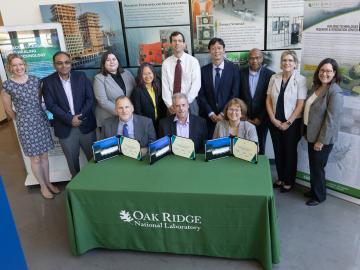
Filter News
Area of Research
- Biology and Environment (10)
- Computer Science (2)
- Electricity and Smart Grid (1)
- Energy Science (19)
- Functional Materials for Energy (2)
- Fusion and Fission (1)
- Isotopes (1)
- Materials (50)
- Materials Characterization (2)
- Materials for Computing (2)
- Materials Under Extremes (1)
- National Security (1)
- Neutron Science (10)
- Quantum information Science (2)
- Supercomputing (21)
News Type
News Topics
- (-) Materials (71)
- (-) Quantum Science (35)
- 3-D Printing/Advanced Manufacturing (59)
- Advanced Reactors (14)
- Artificial Intelligence (46)
- Big Data (17)
- Bioenergy (29)
- Biology (30)
- Biomedical (21)
- Biotechnology (12)
- Buildings (22)
- Chemical Sciences (44)
- Clean Water (2)
- Composites (14)
- Computer Science (79)
- Coronavirus (17)
- Critical Materials (11)
- Cybersecurity (18)
- Education (3)
- Element Discovery (1)
- Emergency (1)
- Energy Storage (48)
- Environment (51)
- Exascale Computing (23)
- Fossil Energy (1)
- Frontier (24)
- Fusion (19)
- Grid (21)
- High-Performance Computing (46)
- Irradiation (1)
- Isotopes (24)
- ITER (3)
- Machine Learning (17)
- Materials Science (60)
- Mercury (2)
- Microelectronics (1)
- Microscopy (20)
- Molten Salt (3)
- Nanotechnology (32)
- National Security (23)
- Neutron Science (61)
- Nuclear Energy (36)
- Partnerships (34)
- Physics (27)
- Polymers (14)
- Quantum Computing (16)
- Security (12)
- Simulation (15)
- Software (1)
- Space Exploration (3)
- Statistics (1)
- Summit (24)
- Transportation (37)
Media Contacts

A research team from the Department of Energy’s Oak Ridge National Laboratory, in collaboration with North Carolina State University, has developed a simulation capable of predicting how tens of thousands of electrons move in materials in real time, or natural time rather than compute time.
Mariam Kiran, a quantum research scientist at the Department of Energy’s Oak Ridge National Laboratory, was recently honored as a finalist at the British Council’s Study U.K. Alumni Awards 2025, which celebrate the achievements of U.K. alumni worldwide.

Working at nanoscale dimensions, billionths of a meter in size, a team of scientists led by ORNL revealed a new way to measure high-speed fluctuations in magnetic materials. Knowledge obtained by these new measurements could be used to advance technologies ranging from traditional computing to the emerging field of quantum computing.

Neus Domingo Marimon, leader of the Functional Atomic Force Microscopy group at the Center for Nanophase Materials Sciences of ORNL, has been elevated to senior member of the Institute of Electrical and Electronics Engineers.

Researchers at ORNL joined forces with EPB of Chattanooga and the University of Tennessee at Chattanooga to demonstrate the first transmission of an entangled quantum signal using multiple wavelength channels and automatic polarization stabilization over a commercial network with no downtime.

Researchers led by the University of Melbourne, Australia, have been nominated for the Association for Computing Machinery’s 2024 Gordon Bell Prize in supercomputing for conducting a quantum molecular dynamics simulation 1,000 times greater in size and speed than any previous simulation of its kind.

A new technology to continuously place individual atoms exactly where they are needed could lead to new materials for devices that address critical needs for the field of quantum computing and communication that cannot be produced by conventional means.

A team led by scientists at ORNL identified and demonstrated a method to process a plant-based material called nanocellulose that reduced energy needs by a whopping 21%, using simulations on the lab’s supercomputers and follow-on analysis.

Flexcon Global has exclusively licensed two patented inventions to manufacture a self-healing barrier film from ORNL for research and development purposes. The film can be incorporated into vacuum insulation panels to increase the efficiency of buildings during retrofits. Under a cooperative research and development agreement that began in 2021, Flexcon and ORNL have been exploring the capabilities of the technology and fine-tuning its properties.

A study by more than a dozen scientists at the Department of Energy’s Oak Ridge National Laboratory examines potential strategies to integrate quantum computing with the world’s most powerful supercomputing systems in the pursuit of science.


